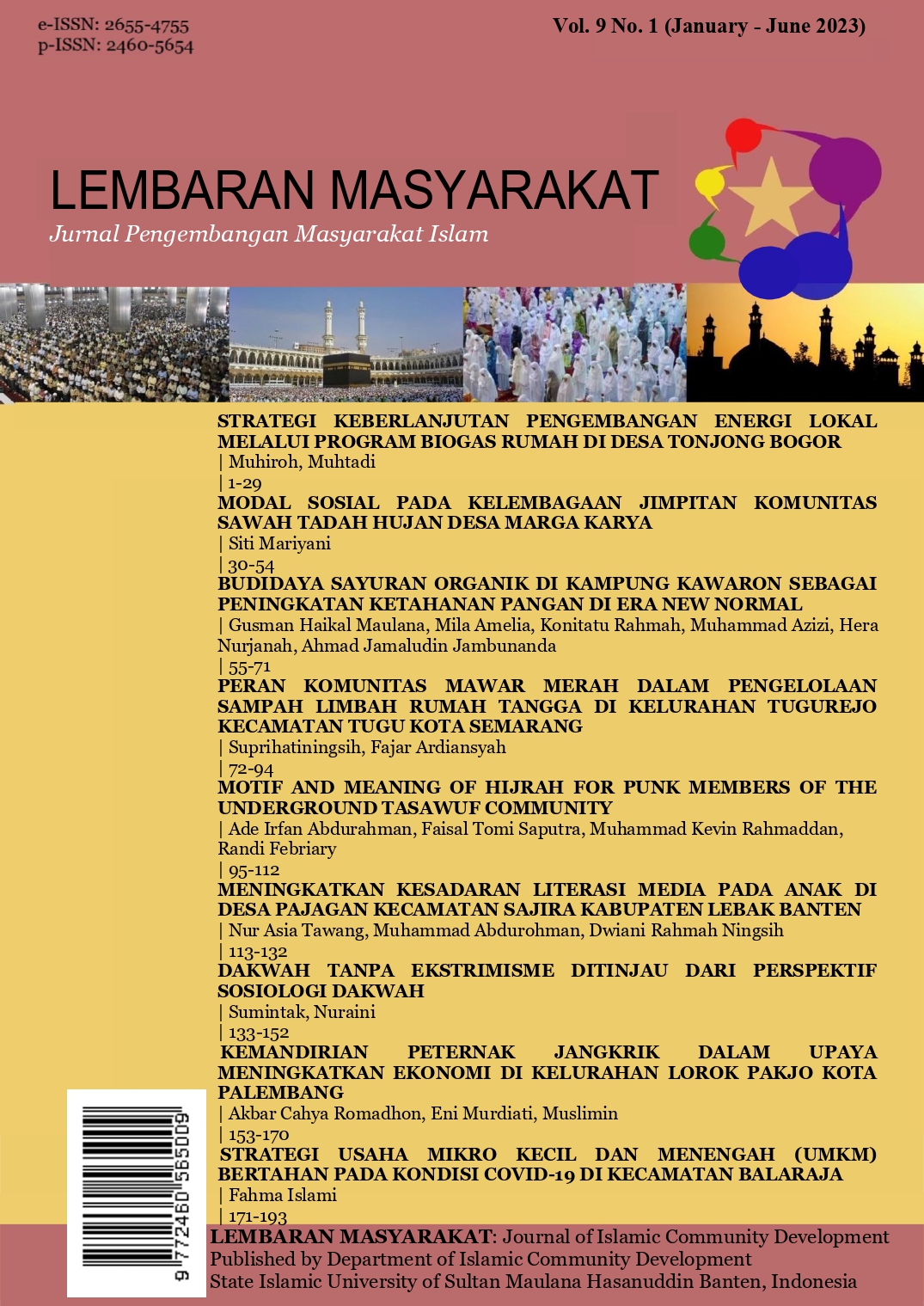MODAL SOSIAL PADA KELEMBAGAAN JIMPITAN KOMUNITAS PETANI SAWAH TADAH HUJAN DESA MARGA KAYA
DOI:
https://doi.org/10.32678/lbrmasy.v9i1.8169Keywords:
Keywords: Farmer, Institution, Jimpitan, Social capital.Abstract
The current institutional challenges of jimpitan are causing the jimpitan institution to experience upheaval, namely the crisis persists or begins to fade. The fading or survival of the jimpitan institution is inseparable from the social capital of the farming community. This study aims to determine social capital in the rain-fed farming community's jimpitan institution in Marga Kaya Village. The research method is in-depth interviews with selected informants by purposive sampling. The data analysis used was descriptive qualitative. The research activities were carried out in January-April 2019. The research location was chosen purposively, namely Marga Kaya Village, Jati Agung District, South Lampung Regency. Social capital in the Jimpitan institutional community of rainfed rice farmers in Marga Kaya Village is seen from three things, namely trust, norms and networks. Networking, namely connecting between farmers by communicating and conveying information regarding jimpitan activities as well as networking with outside communities such as within the Rukun Tetangga (RT) and village level. The norm is that there are rules that apply, such as the schedule for taking jimpitan at night during night patrols and the form of jimpitan in the form of rice or money according to the agreement of each Rukun Tetangga (RT). Trust is seen in jimpitan management activities by the RT head and administrators which are then used for the benefit of the common people.
Downloads
References
Ariati, H. C., & Hidayat, R. (2013). Pelaksanaan kegiatan jimpitan dalam pemenuhan kebutuhan pembangunan berbasis komunitas ( Studi di RW 23 Sadengan Kelurahan Kebonsari Kecamatan Sumbersari Kabupaten Jember). Journal of Chemical Information and Modeling, 9, 1–6.
Babbie, E. (2014). The Practice of Social Research (Fourteenth). Cengange Learning. https://doi.org/10.2307/1318620
Badan Pusat Statistik. (2021). Jati Agung Dalam Angka 2021. BPS.
Coleman, J. S. (1988). Social Capital in the Creation of Human Capital. American Journal of Sociology, 94(1988), S95–S120.
Ellis, F. (2000). The determinants of rural livelihood diversification in developing countries. Journal of Agricultural Economics, 51(2), 289–302. https://doi.org/10.1111/j.1477-9552.2000.tb01229.x
Harsono, W. (2014). Jimpitan, Modal Sosial yang Menjadi Solusi Permasalahan Masyarakat. JKAP (Jurnal Kebijakan Dan Administrasi Publik), 18(2), 131–146.
Hasym, M., & Pratama, O. G. P. (2014). Pelestarian Tradisi Uang Jimpitan di Lingkungan Dusun Ggepuh Lor, Desa Banyusidi, Pakis, Magelang, Jawa Tengah. Jurnal Inovasi Dan Kewirausahaan, 3(3), 151–154.
Izzati, F. R., Putri, F. R., Salim, A. S. P., Putri, S. A., Valentin, R. J., & Al Hamda, A. (2021). Sejarah dan Budaya Jawa. Jurnal Sejarah Dan Budaya, I(2), 1–60. https://doi.org/10.17977/um021v15i22021p344
Mariyani, S., Pandjaitan, N. K., & Sihaloho, M. (2019). Resilience of Rainfed Lowland Farming Communities on the Threat of Food Insecurity due to Climate Change (A Case in South Lampung). Sodality: Jurnal Sosiologi Pedesaan, 7(3). https://doi.org/10.22500/sodality.v7i3.27390
Mariyani, S., Pandjaitan, N. K., & Sihaloho, M. (2022). Peran Kelembagaan Pangan Komunitas Petani Sawah Tadah Hujan di Kabupaten Lampung Selatan. Jurnal Agrimanex: Agribusiness, Rural Management, and Development Extension, 2(2), 142–153. https://doi.org/10.35706/agrimanex.v2i2.6361
Norris, F. H., Stevens, S. P., Pfefferbaum, B., Wyche, K. F., & Pfefferbaum, R. L. (2008). Community resilience as a metaphor, theory, set of capacities, and strategy for disaster readiness. American Journal of Community Psychology, 41(1-2), 127–150. https://doi.org/10.1007/s10464-007-9156-6
Pambudi, R. D. (2020). Pelestarian Jimpitan sebagai Upaya Pemberdayaan Masyarakat dalam Pembangunan di Kelurahan Patemon, Gunung Pati, Kota Semarang. Forum Ilmu Sosial, 47(1), 37–45.
Putnam, B. R. D. (1993). The Prosperous Community: Social Capital and Public Life. The American Prospect, 4, 35–42.
Saheb, S., Slamet, Y., & Zuber, A. (2018). Peranan Modal Sosial Bagi Petani Miskin Untuk Mempertahankan Kelangsungan Hidup Rumah Tangga Di Pedesaan Ngawi (Studi Kasus Di Desa Randusongo Kecamatan Gerih Kabupaten Ngawi Provinsi Jawa Timur). Jurnal Analisa Sosiologi, 2(1), 17–34. https://doi.org/10.20961/jas.v2i1.17382
Saifullah, N. (2021). Jimpitan Peneleh: Aksis Sosial Untuk Bangkit di Musim Pandemi. In Harmoni Agama dan Sains: Analogi Esai Spirit Bangkit Pasca Pandemi (pp. 41–50). Literasi Nusantara Abadi.
Sari, K. A. W., Eskasasnanda, I. D. P., & Idris. (2020). Jimpitan; Tradisi Masyarakat Kota Di Era Modern. Sejarah Dan Budaya : Jurnal Sejarah, Budaya, Dan Pengajarannya, 14(1), 53. https://doi.org/10.17977/um020v14i12020p53-61
Setiawan, T. P., Ebrilyani, E., & Azilla, E. N. (2020). Modal Sosial Dalam Keberlanjutan Pertanian Di Tengah Alih Fungsi Lahan Di Kelurahan Bintoro Kecamatan Patrang Kabupaten Jember. Agricore: Jurnal Agribisnis Dan Sosial Ekonomi Pertanian Unpad, 5(1), 59–69. https://doi.org/10.24198/agricore.v5i1.27464
Setyawan, B. W., & Sofiatu, N. A. (2021). Tradisi Jimpitan Sebagai Upaya Membangun Nilai Sosial Dan Gotong Royong Masyarakat Jawa. Jurnal Diwangkara, 1(1), 7–15.
Surono. (2012). Build The Economic Integration With Jimpitan Model In Javanese Society. 2nd International Conference on International Relations and Development (ICIRD 2012) “Towards an ASEAN Economic Community (AEC) - Prospects, Challenges, and Paradoxes in Development, Governance and Human Security” Chiang Mai Thailand) Surono, 1–5.
Syahra, R. (2003). Modal sosial: Konsep dan aplikasi. Jurnal Masyarakat Dan Budaya, 5(1), 1–22. http://www.jurnalmasyarakatdanbudaya.com/index.php/jmb/article/view/256
Taufik, M. F., & Adtuti D, S. I. (2018). Modal Sosial Sebagai Strategi Kelangsungan Industri Pengolahan Batu dan Pasir di Dusun Giyan Bimomartani Ngemplak Sleman. Jurnal Pendidikan Sosiologi, 13(1), 104–116.
Downloads
Published
Issue
Section
License
Copyright (c) 2023 Lembaran Masyarakat: Jurnal Pengembangan Masyarakat Islam

This work is licensed under a Creative Commons Attribution-NonCommercial 4.0 International License.









.png)
.png)
.png)

.png)











